That dreaded moment when you turn the key and hear nothing but a click can ruin anyone’s day. If your car refuses to start, a worn-out battery is often the culprit. Even the most reliable vehicles eventually need this crucial component replaced.
Most Toyota owners will face battery issues at some point in their driving journey. While regular maintenance helps extend your vehicle’s lifespan, power cells typically last between 3-5 years before showing signs of weakness. Recognizing these warning signs early can prevent unexpected breakdowns and roadside frustrations.
This comprehensive resource walks you through everything from identifying when your power source needs changing to step-by-step instructions for various models. Whether you’re a hands-on enthusiast or simply want to understand what happens during professional service, you’ll find essential knowledge to ensure reliable starts every time.
We’ll explore different power cell types, necessary tools, safety precautions, and maintenance tips to maximize longevity. Keeping your electrical system in top condition is crucial for preserving the legendary reliability that makes these Japanese vehicles so popular among American drivers.
Understanding Toyota Battery Basics
Knowing how your Toyota’s battery works is key to keeping your car running well. It doesn’t just start the engine. It also powers your headlights and radio. So, it’s very important.
Types of Batteries Used in Toyota Vehicles
Toyota cars use different batteries, depending on the model and year. Most have lead-acid batteries. These are reliable, affordable, and meet the needs of non-hybrid cars.
Hybrid models, like the Prius, have a more complex setup. They have a high-voltage battery pack for the electric motor and a 12V battery for electronics. The high-voltage batteries are usually lithium-ion or nickel-metal hydride.
TrueStart™ batteries are made just for Toyota. They’re tested to ensure they work well and meet Toyota’s quality standards.
Battery Lifespan in Different Toyota Models
The life of a Toyota battery usually ranges from 3-5 years. But, it can change based on how you drive. Short trips can harm the battery, while long drives help keep it healthy.
Weather also affects battery life. Heat speeds up chemical reactions, causing the battery to wear out faster. Cold weather makes starting harder and reduces efficiency.
Different models have different battery lifespans. For example, a Camry might last longer than a Land Cruiser because of its extra features.
Signs Your Toyota Battery Needs Replacement
Knowing the signs of a failing battery can save you from being stuck with a dead one. Most batteries show symptoms before they fail completely.
Visual Indicators
Look for corrosion around the terminals during regular checks. This white, blue, or green substance can block connections and lower performance.
A swollen or bulging battery case means it’s damaged and needs to be replaced. Cracks in the case are also a warning sign.
Check the battery’s charge indicator if it has one. A small window on top shows the charge level. Green is good, black means it needs charging, and yellow or clear means it’s time for a new one.
Performance Issues
Slow engine cranking is a common sign of a failing battery. If your engine turns over slowly before starting, your battery might be losing its charge.
Dimming headlights, especially when using many electrical features, also indicate a problem. You might notice power windows working slower or the radio resetting.
Need to jump-start your car often? That’s a sign your battery can’t hold a charge. The dashboard battery warning light can also come on when the battery is low, but it might also mean the alternator is failing.
Strange smells, like a rotten egg smell, when you open the hood can mean the battery is overheating or leaking. If you smell this and see other signs, it’s time to replace your battery.
When to Replace Your Toyota Battery
Knowing when to replace your Toyota battery is key to keeping your car running smoothly. Many people wait too long, but knowing the signs can save you from being stuck with a dead battery. It’s important to understand how long your battery should last and when it’s time for a new one.
Average Battery Lifespan by Toyota Model
Most Toyota batteries last between 3-5 years. However, this can change based on the model and how you drive. Sedans like the Camry and Corolla usually last longer than SUVs and trucks.
| Toyota Model | Average Battery Lifespan | Factors Affecting Longevity | Recommended Check Frequency |
|---|---|---|---|
| Camry/Corolla | 4-5 years | Climate, driving habits, electrical usage | Every 6 months after 3 years |
| RAV4/Highlander | 3-4 years | Higher accessory power demands | Every 4-6 months after 2 years |
| Tacoma/Tundra | 3-5 years | Extreme temperature exposure, off-road use | Every 3-4 months after 2 years |
| Prius (12V battery) | 4-6 years | Hybrid system assistance, driving patterns | Annually after 3 years |
Seasonal Factors Affecting Battery Performance
Your Toyota’s battery works differently with the seasons. Many think winter is toughest, but summer heat actually causes more damage. Heat speeds up chemical reactions inside the battery, leading to corrosion and water loss.
Winter cold doesn’t harm batteries permanently but lowers their power temporarily. This is why a battery weakened by summer heat often fails in winter’s first cold snap. Starting the car then requires more power.
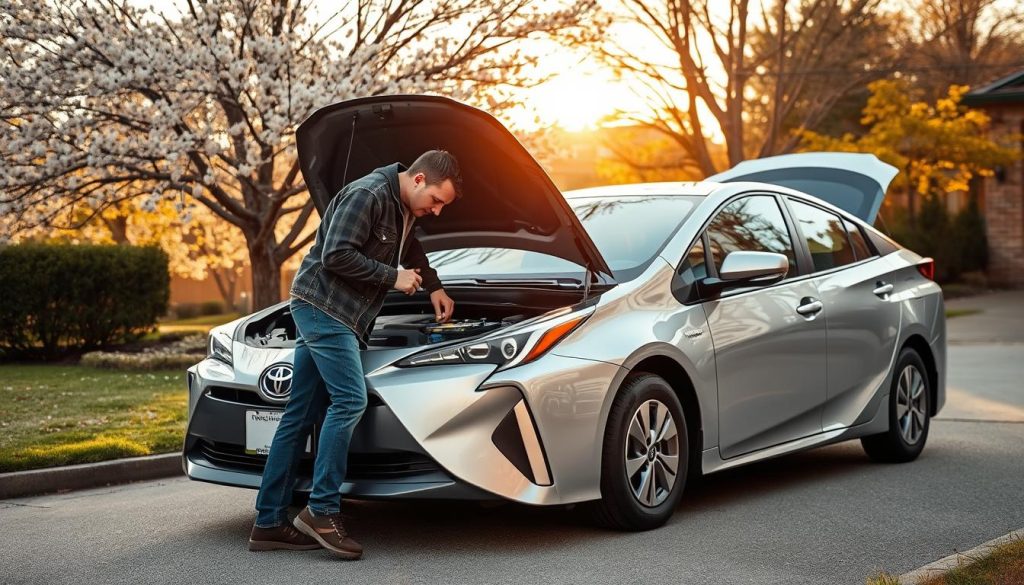
Warning Signs of Battery Failure
Knowing the early signs of battery failure can help you replace it before it’s too late. Look out for these important indicators that your battery is nearing the end of its life.
Dashboard Warning Lights
The most obvious sign is the battery warning light on your dashboard. This light looks like a battery and means your charging system isn’t working right. If this light comes on while driving, your alternator might not be charging the battery well.
Modern Toyotas may also show specific battery messages on the info display. These messages give more details about the problem.
Starting Problems
Starting issues are clear signs of battery trouble. Watch for these symptoms:
- Slow cranking – Engine turns over more slowly than usual
- Clicking sounds – Rapid clicking when turning the key
- Multiple start attempts – Engine requires several tries to start
- Intermittent starting issues – Sometimes starts normally, other times struggles
If your Toyota needs a jump start more than once a month, it’s a warning sign. Getting your battery checked early can prevent being stranded with a car that won’t start.
Dim headlights when the engine is off or if electrical accessories seem weak are also signs. These symptoms mean it’s time to think about replacing your battery before you face a big problem.
Choosing the Right Battery for Your Toyota
Choosing the right battery for your Toyota is key. It affects everything from starting in cold weather to how long your car lasts. The right choice means your car works well in all conditions and you get the most value.
OEM vs. Aftermarket Battery Options
Toyota owners must decide between OEM and aftermarket batteries. Toyota TrueStart™ batteries are made just for your car. They give the best cold cranking amps and reserve capacity for any weather.
OEM batteries cost more but are more reliable and fit perfectly. Aftermarket batteries might save money but can be less reliable. For the best Toyota battery replacement tips, remember that Toyota batteries are tested and approved by Toyota engineers for years of service.
Battery Specifications for Popular Toyota Models
Sedan Models (Camry, Corolla, Avalon)
Toyota sedans need specific batteries based on engine size and electrical needs:
- Camry: Needs a Group 35 battery with 590-600 CCA
- Corolla: Uses a Group 35 or 24F battery with 550-600 CCA
- Avalon: Needs a Group 24F battery with 600+ CCA
SUV Models (RAV4, Highlander, 4Runner)
SUVs need more power for extra electrical parts:
- RAV4: Requires Group 35 batteries with 590-600 CCA
- Highlander: Needs Group 24F with 650+ CCA
- 4Runner: Uses Group 24F or 35 with 650-750 CCA for off-road reliability
Truck Models (Tacoma, Tundra)
Toyota trucks need strong batteries for tough conditions:
- Tacoma: Uses Group 24F or 27F batteries with 650-750 CCA
- Tundra: Requires Group 27F with 750+ CCA for heavy-duty performance
Cold Cranking Amps (CCA) Requirements
CCA rating is key in cold climates. It shows a battery’s ability to start your engine in cold. For most Toyotas in mild climates, 600 CCA is enough. But in very cold areas, choose batteries with 750+ CCA for better starts.
Battery Warranty Considerations
Warranty coverage differs among makers. Top batteries usually have 3-5 year warranties. Economy options might only last 1-2 years. Toyota TrueStart™ batteries have long warranties, giving you peace of mind.
Essential Tools for Toyota Battery Replacement
Starting a DIY Toyota battery replacement means getting the right tools first. This avoids frustration and keeps you safe during the job.
You don’t need fancy tools to replace your Toyota’s battery. But, missing out on key tools can make the job tough. Let’s look at what you’ll need to do it right.
Basic Tools Required
For a Toyota battery swap, you need some basic tools. A wrench set, usually 10mm or 12mm, is key for tightening and loosening connections. Pliers help with tight clamps and positioning. A wire brush or terminal cleaner removes corrosion that can mess up electrical connections.
A memory saver plugs into your car’s 12V outlet. It saves radio presets, clock settings, and electronic data while the battery is out. It’s optional but worth $15-20 to avoid reprogramming everything later.
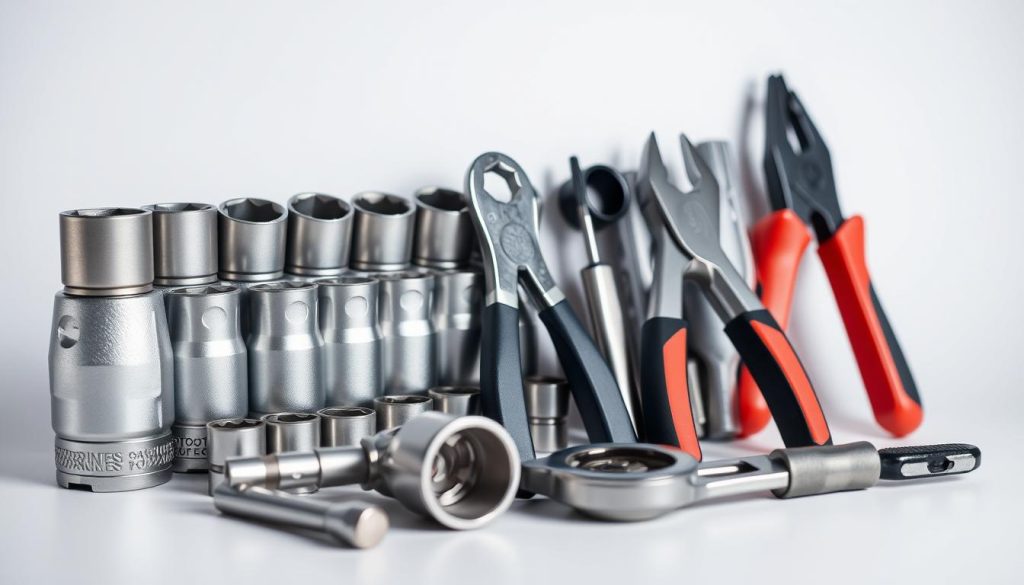
Optional Tools for Easier Replacement
Some tools are not needed but make the job easier. A battery carrying strap helps move the heavy old battery safely. Car batteries are 30-50 pounds, so this tool is great for avoiding back injuries.
A battery terminal puller removes stubborn connections without damaging them. A battery tester checks your new battery’s condition before you install it. This can save you from a bad battery.
| Tool Category | Essential Tools | Purpose | Approximate Cost |
|---|---|---|---|
| Basic | Wrench Set (10-12mm) | Terminal connection removal | $10-20 |
| Basic | Pliers | Handling clamps and cables | $8-15 |
| Basic | Wire Brush | Cleaning corrosion | $5-10 |
| Optional | Memory Saver | Preserving electronics settings | $15-25 |
| Optional | Battery Carrying Strap | Safe battery transport | $10-15 |
Safety Equipment Recommendations
Replacing a battery can be dangerous. Always use the right safety gear when working on your Toyota.
Personal Protection
Chemical-resistant gloves protect your hands from battery acid, which can burn badly. Safety glasses keep your eyes safe from acid splashes or debris. Wear long-sleeved clothes to avoid acid touching your skin.
Vehicle Protection
Fender covers prevent scratches on your Toyota’s paint. Keep a baking soda and water mix ready to clean acid spills fast. A battery mat under the work area catches spills and protects your garage floor.
With these tools and safety gear ready, you’re set to replace your Toyota’s battery confidently and efficiently. The right preparation ensures your safety and the success of your DIY project.
Safety Precautions Before Battery Replacement
Before starting a Toyota battery replacement, knowing the safety steps is key. Working with batteries means dealing with electrical dangers and harmful chemicals. It’s important to be careful.
When you do a Toyota battery installation, safety comes first. Even simple tasks can be risky if you don’t follow the right steps. Here are the key safety tips to remember before you begin.
Electrical Safety Measures
Keeping yourself and your car’s electrical parts safe is crucial. First, turn off the car and remove the key. Make sure all lights, radios, and climate controls are off too.
Use a memory saver device to keep your car’s computer running. It plugs into your car’s OBD-II port or cigarette lighter. This tool keeps your car’s settings, like radio presets, safe while you replace the battery.
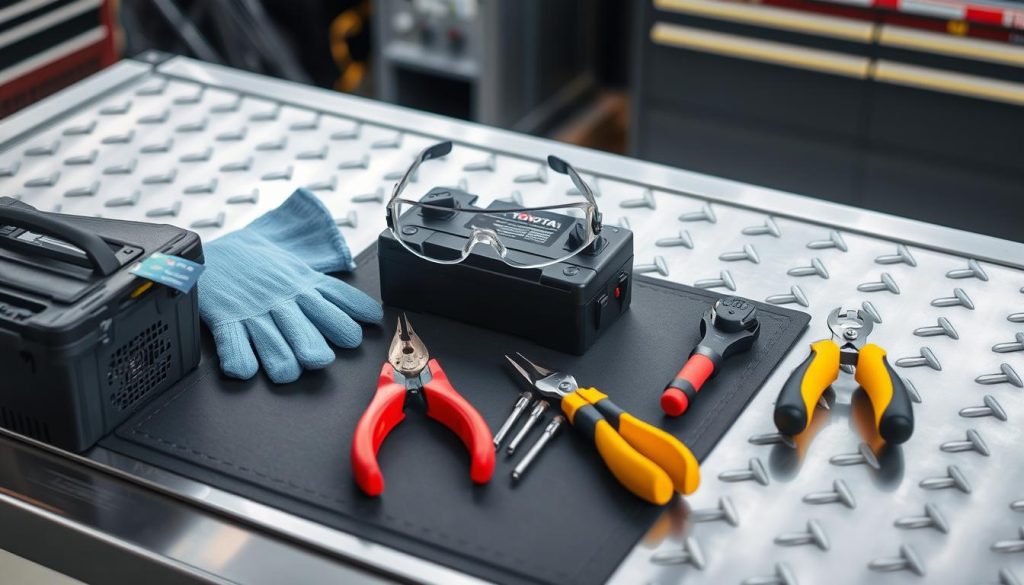
Take off any metal jewelry before working on your battery. This includes watches, rings, and bracelets. They can cause electrical shorts. Wearing insulated gloves also helps protect you from shocks.
Vehicle Preparation Steps
Getting your car ready is important for a safe Toyota battery installation. Park on a flat, stable surface and use the parking brake. If you’ve been driving, let the engine cool down first.
Have all your tools and safety gear ready before you start. Work in a well-ventilated area, like outdoors or a garage with open doors. Batteries can release hydrogen gas.
Find your car’s battery using your owner’s manual. Some Toyotas have batteries in tricky spots, like under the rear seat or in the trunk.
Handling and Disposing of Old Batteries Safely
When taking out your old battery, lift it from the base or use a strap. Never grab the terminals to avoid damage and short circuits. Always keep the battery upright to prevent acid spills.
Acid Spill Prevention
Battery acid is very corrosive and can burn your skin and damage clothes. Handle your battery carefully to avoid spills. Have baking soda ready to clean up any spills.
If you spill acid, pour baking soda on it right away. For skin spills, rinse with cold water for 15 minutes. See a doctor if you need to.
Terminal Protection
When taking off battery cables, start with the negative (black) terminal and end with it. This stops sparks that could ignite hydrogen gas. Use a terminal puller tool instead of prying the connections.
After disconnecting, cover the terminal ends with caps or tape. Keep the cables away from metal and each other.
Old batteries have harmful materials and must be recycled. Most auto parts stores, Toyota dealerships, and recycling centers take old batteries for free. Don’t throw them away in regular trash as it’s illegal and bad for the environment.
By following these safety steps, your Toyota battery installation instructions will be safe and successful. With these precautions, you can replace your battery confidently and protect yourself, your car, and the environment.
Toyota Battery Replacement Guide: Step-by-Step Process
This guide makes replacing your Toyota battery easy. It’s all about following simple steps. You’ll save money and time by doing it yourself, compared to a professional.
Locating the Battery in Different Toyota Models
Toyota cars have batteries in different spots. In sedans like the Camry and Corolla, it’s on the passenger side. SUVs like the RAV4 might have it on the driver’s side.
Newer Toyotas might have the battery hidden. It could be under a cover or in the trunk. Always check your owner’s manual for the exact spot.
Disconnecting the Old Battery
First, park on a flat, dry surface. Make sure the engine is off and cool. Put the car in Park and engage the emergency brake.
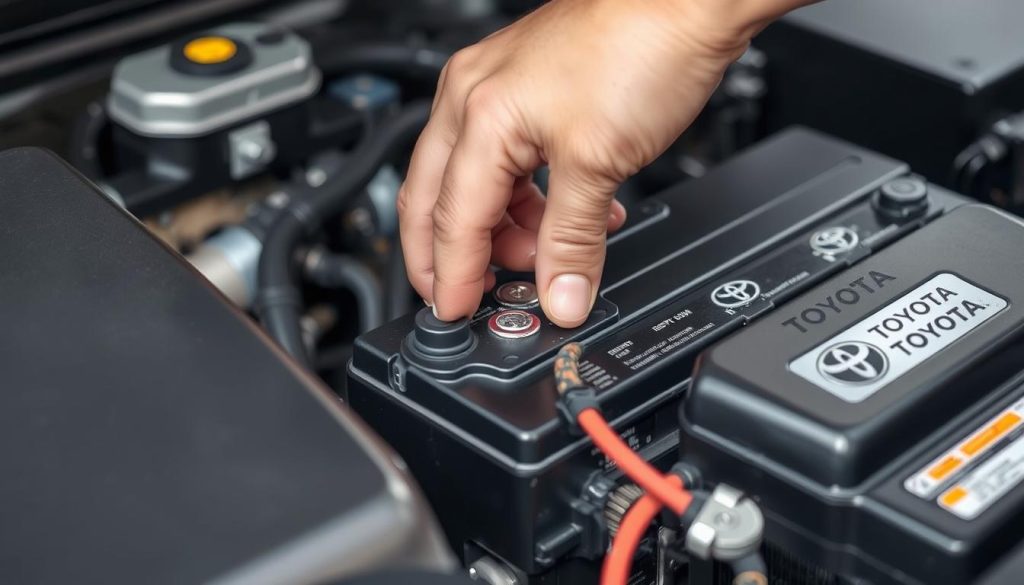
1. Find the positive terminal (marked with “+” and red)
2. Look for the negative terminal (marked with “-” and black)
3.Always disconnect the negative terminal first, then the positive
4. Loosen the nuts with a wrench without touching metal
This way, you avoid electrical shorts and sparks. These could harm your car’s electronics or hurt you.
Dealing with Corroded Terminals
Corrosion looks like white, green, or blue powder on the terminals. To clean them:
1. Spray with a battery cleaner or baking soda and water
2. Scrub with a wire brush until shiny
3. Rinse and dry well
Removing the Old Battery
After disconnecting and cleaning the terminals:
1. Loosen the battery clamp with the right wrench
2. Lift the old battery straight up with a strap or handles
3. Be careful, as Toyota batteries are heavy
Installing the New Battery
Make sure the new battery fits like the old one. Place it in the tray carefully. Then, secure it with the bracket or clamp.
Reconnecting Terminal Cables
Proper Terminal Connection Sequence
When reconnecting, do it in reverse:
1. Connect thepositive terminal first(red, “+”)
2. Then the negative terminal (black, “-“)
3. Make sure they’re snug but not too tight
Terminal Protection Tips
To keep corrosion away and extend battery life:
1. Apply petroleum jelly or terminal protectant
2. Use terminal protectors if available
3. Replace any covers
Check all connections before closing the hood. If your Toyota starts right away, you did it right. If not, check your work again.
Specific Battery Replacement Instructions for Popular Toyota Models
Knowing how to replace batteries in popular Toyota models can save you time and avoid problems. Each Toyota has its own way of securing the battery, so pay close attention to these details.
Toyota Camry Battery Replacement
2012-2022 Models
The battery in 2012-2022 Toyota Camry models is on the passenger side of the engine. Start by taking off the plastic cover that protects the battery. You’ll need to release clips or remove small bolts with a socket wrench.
In 2018 and newer Camry models, you’ll need to move aside more air intake parts for full access. Use a 10mm socket to loosen the battery hold-down bracket. Then, disconnect the negative terminal first (black, marked with a minus sign) before the positive terminal (red, marked with a plus sign).
Pre-2012 Models
Pre-2012 Camry models are easier to work on with fewer parts in the way. For 2007-2011 models, find the battery hold-down bracket and remove it with a 10mm socket. Earlier models might have simpler fasteners but still follow the same safety order for disconnecting terminals.
Toyota Corolla Battery Replacement
The battery in most Toyota Corolla models is on the right (passenger) side of the engine. For 2014 and newer Corollas, you’ll need to remove a plastic cover and possibly the air intake hose for better access.
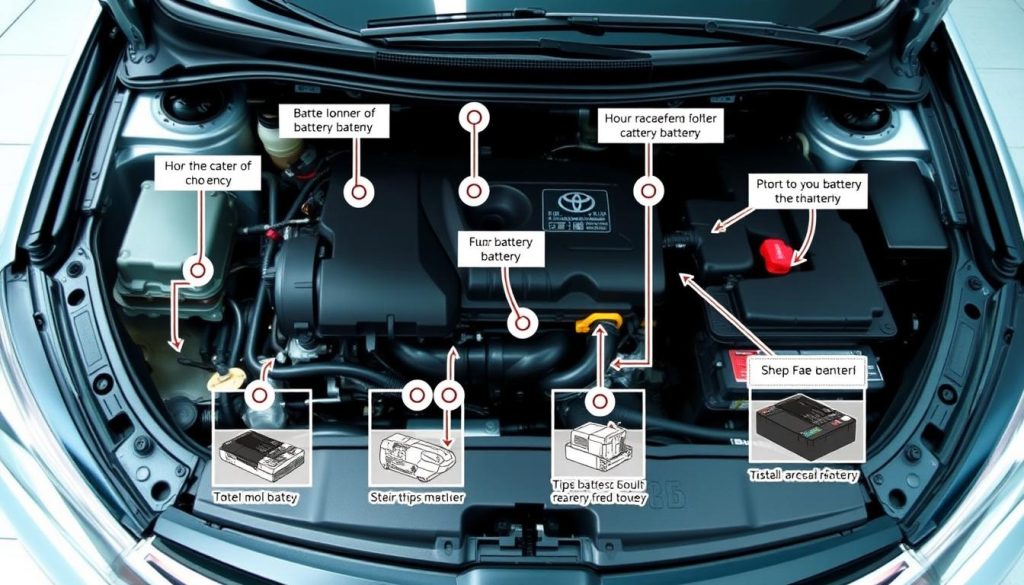
Corolla models from 2003-2013 have easier access to the battery but need the removal of a battery hold-down bar secured by 10mm bolts. After loosening these bolts, lift the battery straight up to avoid damage to surrounding parts.
Toyota RAV4 Battery Replacement
The battery location in RAV4 models changes with each generation. In 2019 and newer RAV4s, the battery is on the driver’s side under a plastic cover. For 2013-2018 models, it’s on the passenger side.
Some RAV4 models need you to remove or loosen the windshield washer fluid reservoir for access. Use a 10mm wrench to remove the hold-down clamp before carefully lifting out the old battery.
Toyota Tacoma and Tundra Battery Replacement
Toyota trucks use larger, heavier batteries with more cold cranking amps (CCA). In most Tacoma models, the battery is on the driver’s side, secured by a strong hold-down bracket that requires a 12mm socket.
Tundra models usually have the battery on the passenger side with similar securing mechanisms. Due to the battery’s weight, consider using a battery carrying strap or getting help when removing and installing these larger units.
| Toyota Model | Battery Location | Tools Required | Special Considerations |
|---|---|---|---|
| Camry (2012-2022) | Passenger side | 10mm socket, pliers | Remove plastic cover and air intake components |
| Corolla (2014+) | Passenger side | 10mm socket, screwdriver | Disconnect air intake hose |
| RAV4 (2019+) | Driver’s side | 10mm socket, pliers | Remove plastic cover |
| Tacoma/Tundra | Varies by year | 12mm socket, battery carrier | Higher CCA requirements, heavier battery |
Dealing with Complex Battery Systems in Hybrid Toyota Models
Toyota hybrids have special battery systems that need extra care. If you’re wondering how to replace Toyota battery parts in a hybrid, it’s important to know. These cars use two power sources, making maintenance more complex than usual.
Models like the Prius, Camry Hybrid, and RAV4 Hybrid use this advanced tech. This means their batteries need special handling.
Prius Battery Replacement Considerations
The Prius battery is different from others. It’s found in the trunk, not under the hood. This battery is smaller but still needs to be replaced every 3-5 years.
Replacing it requires careful handling of electrical parts. Always check your owner’s manual for specific instructions before starting.
Hybrid Battery vs. 12V Auxiliary Battery
It’s key to know the difference between the hybrid and 12V batteries. The hybrid battery powers the electric motor and works with the gasoline engine. It lasts 8-10 years or 100,000-150,000 miles and should only be serviced by certified techs.
The 12V battery, however, powers the car’s electronics and computer systems. It also starts the hybrid system when you turn on the car. This battery is safe for DIY replacement.
Special Tools for Hybrid Battery Maintenance
Hybrid batteries need special tools for maintenance. Safety is the top priority when working with these systems.
Diagnostic Equipment
For diagnosing hybrid battery issues, you need hybrid-specific OBD-II scanners. These tools can read codes and battery health indicators that standard scanners can’t. Professional tools help figure out if the hybrid battery or 12V battery needs replacement.
Safety Tools
When working with hybrids, safety tools are essential. Technicians use insulated gloves, face shields, and special tools. They also use safety barriers to avoid high-voltage contact.
For most Toyota owners, it’s best to replace the 12V battery themselves. Leave the high-voltage hybrid battery work to certified Toyota technicians. They have the right training and tools for safe handling.
Post-Replacement Procedures and Testing
Replacing a Toyota battery is just the start. It’s important to set up and test the new battery right. This ensures it works well and avoids future problems.
Resetting Vehicle Electronics
When you remove your Toyota’s battery, many systems forget their settings. Resetting these systems brings your car back to normal.
Radio and Clock Settings
After a battery change, you need to reset some settings on your Toyota:
- Reset the clock to the current time
- Reprogram your favorite radio stations
- Enter security codes for your audio system (check your owner’s manual for these codes)
- Recalibrate navigation systems if your vehicle has one
ECU Adaptations
Your Toyota’s Engine Control Unit (ECU) learns your driving habits. When the battery is removed, it forgets. Don’t be alarmed if your car feels different at first. It’s just adjusting to your driving again.
You might notice changes in:
- Throttle response sensitivity
- Transmission shift patterns
- Idle speed behavior
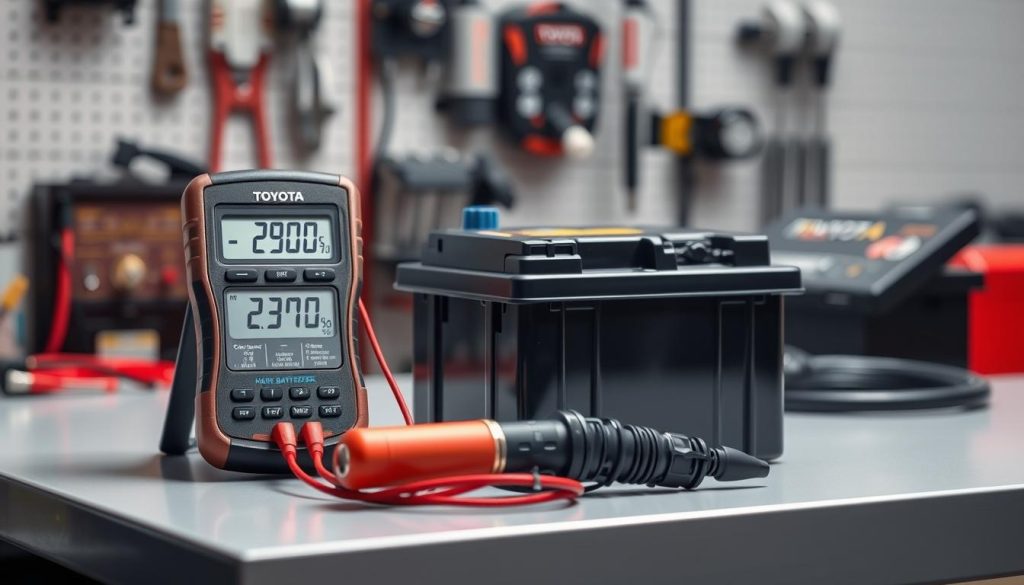
Testing the New Battery’s Performance
Before finishing, test your new battery to make sure it’s working right:
- Check all electrical systems (lights, signals, power windows)
- Start the engine and listen for normal cranking sounds
- Use a multimeter to verify voltage readings (12.6V when off, 13.7-14.7V when running)
- Have the charging system tested to confirm your alternator is properly charging the battery
Breaking In a New Battery
Start your new Toyota battery off right with these tips:
- Take longer drives (20+ minutes) rather than short trips
- Avoid leaving lights or accessories on when the engine isn’t running
- Limit use of high-power accessories like seat heaters initially
- Consider a full charge with a battery maintainer if the vehicle will sit unused
Following these steps will make your new battery last longer. It ensures your Toyota runs smoothly. This small effort is key to any good Toyota battery maintenance guide.
Toyota Battery Maintenance Tips for Longevity
Keeping your Toyota battery in top shape is key to its long life and good performance. With the right care, you can avoid sudden breakdowns and save money. Here are some important maintenance tips for every Toyota owner.
Regular Battery Inspection Schedule
Regular checks are the first step in battery care. Look at your battery every three months for signs of damage or leaks.
When you get your oil changed, ask the mechanic to check the battery. Most places offer free tests.
For cars over two years old, get an annual load test. This checks how much life your battery has left. It helps catch problems early.
Cleaning Battery Terminals
Dirty terminals can stop your car from starting. Cleaning them keeps your battery working well.
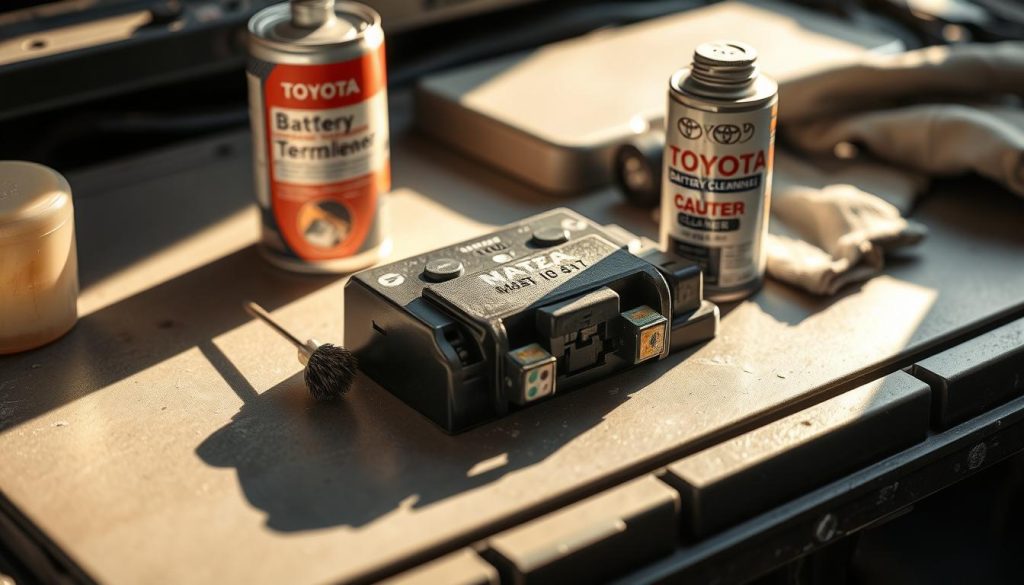
- Wire brush or terminal cleaning tool
- Baking soda and water
- Protective gloves and eyewear
- Clean cloth
Start by disconnecting the battery, always remove the negative terminal first. Make a paste with baking soda and water. Apply it to the terminals to clean them.
Scrub the terminals until they’re shiny. Rinse with water and dry with a cloth before putting everything back.
Corrosion Prevention
After cleaning, put a thin layer of petroleum jelly or a protectant on the terminals. This stops corrosion from coming back.
Use anti-corrosion felt pads around the terminals too. These simple steps can make your battery last longer.
Preventing Battery Drain
Battery drain can make your battery fail early. Always turn off lights and accessories when you leave your car.
If your car sits for a long time, use a battery maintainer. It keeps the battery charged.
If your battery loses charge when it shouldn’t, check for hidden drains. These can slowly drain your battery when it’s off.
Seasonal Battery Maintenance
Your Toyota battery needs special care in different seasons.
In summer, heat can hurt your battery. Check fluid levels and keep it clean and ventilated.
In winter, cold can weaken your battery. Keep it charged and consider using a blanket to keep it warm.
By following this Toyota battery maintenance guide, your car will start well in any weather. Remember, caring for your battery is better than fixing it later.
Troubleshooting Common Toyota Battery Issues
When your Toyota has battery problems, knowing how to fix them can save you money. Even with regular care, battery issues can pop up. Learning about these common problems and using the best Toyota battery replacement tips will keep your car running well.
Battery Not Holding Charge
If your Toyota’s battery drains fast, there could be several reasons. First, look for parasitic drains—parts that use power when the car is off. Things like trunk lights or glove box lights that don’t turn off can be the problem.
Use a multimeter to check your battery’s voltage. It should be around 12.6V when not in use. When the engine is on, it should be between 13.7-14.7V. If it’s lower, your alternator might need fixing.
Slow Engine Cranking
If your Toyota’s engine takes a long time to start, your battery might be old. But it could also mean your starter motor is failing. If your battery tests well but cranking is slow, get a pro to check your starter.
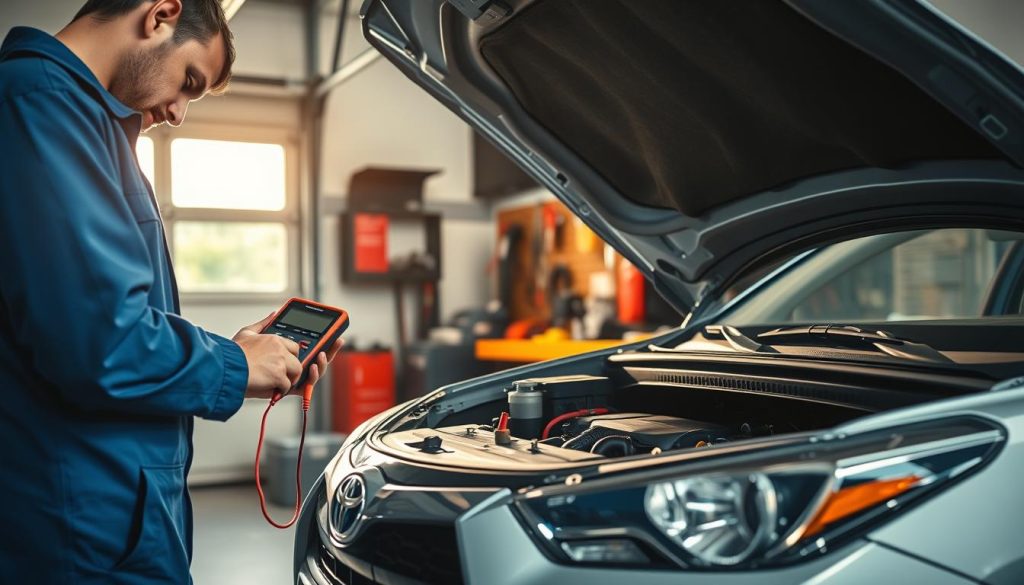
Electrical System Problems After Replacement
Installing a new battery can sometimes cause electrical issues. Make sure you’ve picked the right battery for your Toyota. Also, check that all connections are clean and tight, and the battery is properly seated.
Many Toyotas need an ECU reset after a battery change. Check your owner’s manual or talk to a Toyota expert for the right steps. This will help avoid ongoing problems with your car’s systems.
Dealing with Corroded Terminals
Corrosion on terminals is a common problem that can stop electrical flow. Clean them regularly with a wire brush and baking soda to prevent buildup.
Severe Corrosion Solutions
For really bad corrosion, take the battery out before cleaning. Mix baking soda and water for a strong cleaning solution. Use an old toothbrush to get into tight spots. Rinse well and dry before putting the battery back.
Terminal Replacement Options
If corrosion is too much to clean, you might need to replace the terminals. You can find replacement ends at auto parts stores. If the battery posts are badly corroded, it’s safest to replace the whole battery.
Toyota Battery Replacement Costs
When planning to replace your Toyota battery, knowing the costs can save you a lot of money. It also ensures you get the right battery for your car. Understanding these costs helps you make smart choices that balance quality and price.
DIY vs. Professional Replacement Cost Comparison
Replacing your Toyota battery yourself versus hiring a pro is a big difference in cost. A DIY battery replacement costs only the battery price ($100-$250) and any tools needed.
At a Toyota dealership, the cost is $250-$400. This includes the battery, labor, and disposal. Independent mechanics charge between $180-$300 for the same service.
DIY saves money, but professional installation offers convenience and warranty benefits. These benefits might be worth the extra cost, especially if you’re not into car maintenance.
Battery Price Ranges by Type and Model
Toyota battery prices change based on type and your car model:
| Battery Type | Price Range | Best For | Typical Lifespan |
|---|---|---|---|
| Standard Flooded Lead-Acid | $100-$150 | Corolla, Camry, basic models | 3-4 years |
| Enhanced Flooded | $150-$200 | RAV4, Highlander | 4-5 years |
| AGM (Absorbent Glass Mat) | $180-$250 | Models with start-stop technology | 5-7 years |
| Hybrid Auxiliary | $180-$300 | Prius, Camry Hybrid | 4-6 years |
Where to Buy Toyota Batteries at the Best Price
Dealership Options
Toyota dealerships sell TrueStart™ batteries made for your car. Prices are 15-30% higher, but you get perfect fit, professional install, and warranties.
Auto Parts Retailers
AutoZone, O’Reilly, and Advance Auto Parts have good prices with sales and rebates. They offer free battery tests and install, plus refund for old batteries.
Online Purchasing
Online stores like Amazon and eBay have the cheapest prices, sometimes 20-30% off. But, you must install it yourself, and shipping for heavy batteries can cut savings.
Warranty Considerations and Value
Warranty coverage is key when looking at Toyota battery replacement costs. Premium batteries have 3-5 year warranties, while economy ones have 1-2 years.
A longer warranty battery might cost $30-$50 more but offers better value over time. Toyota TrueStart™ batteries have warranties that cover partial replacement costs for years.
Choosing a quality battery with proper install can prevent expensive electrical issues later. This makes it a smart investment, even with a higher upfront cost.
Environmental Considerations and Battery Recycling
Learning to replace your Toyota battery yourself can save money. But, it’s also important to think about the environment. Car batteries have harmful materials like lead and sulfuric acid that can pollute if not disposed of right.
Proper Disposal of Old Toyota Batteries
Don’t throw away your old Toyota battery in the trash or leave it outside. It’s bad for the environment and against the law in many places. Always plan to dispose of your old battery properly when you replace it.
Many stores give you money back for your old battery when you buy a new one. This helps the planet and can lower the cost of your new battery.
Recycling Programs and Locations
Finding a place to recycle your old Toyota battery is easy. Nearly all auto parts retailers and Toyota dealerships accept used batteries for free. Here are some places you can go:
- AutoZone, Advance Auto Parts, O’Reilly, and Walmart
- Toyota dealership service centers
- Dedicated battery recycling facilities
- Some municipal waste management centers
For the nearest recycling center, check Earth911.com. They have a database by zip code and material type.
Environmental Impact of Battery Choices
The type of battery you choose affects the environment. Lead-acid batteries are bad for the planet to make but can be recycled almost completely if done right.
Standard vs. Enhanced Environmental Options
| Battery Type | Lifespan | Recyclability | Environmental Impact | Cost Difference |
|---|---|---|---|---|
| Standard Lead-Acid | 3-5 years | Nearly 100% | Higher manufacturing impact | Base cost |
| AGM (Absorbent Glass Mat) | 5-7 years | 95-98% | Lower replacement frequency | +$30-60 |
| Enhanced Flooded Battery | 4-6 years | Nearly 100% | Moderate impact | +$15-40 |
| Eco-Friendly Options | 4-6 years | Nearly 100% | Lower production footprint | +$40-80 |
Toyota’s Environmental Initiatives
Toyota has big plans to help the environment. They’re working hard to recycle hybrid batteries, getting 91% of Prius batteries back.
Their “Toyota Environmental Challenge 2050” aims to make their products better for the planet. Recycling your old battery supports these efforts.
Conclusion
We’ve covered everything about replacing your Toyota battery in this guide. You now know how to keep your car’s electrical system running smoothly. This includes spotting warning signs and following the right installation steps.
Timing is key when replacing your battery. Most car batteries last between three to five years. Climate, driving habits, and how much you use your car can affect this.
Always prioritize safety, whether you’re doing it yourself or getting a pro to do it. Use the right tools and follow the correct steps to avoid any issues.
Hybrid Toyota owners need to know the difference between their main battery and the 12V auxiliary battery. Each needs special care and replacement methods.
By following the steps in this guide, you’re making your Toyota more reliable. Don’t forget to recycle your old battery to help the environment.
With your new battery in, your Toyota will run smoothly for years. Taking care of your battery is a small price for all the hassle-free driving it gives you.
FAQ
How often should I replace my Toyota battery?
Toyota batteries usually last 3-5 years. This depends on your car model, how you drive, and the weather. Camry and Corolla batteries often last 4-5 years. SUVs like RAV4 and Highlander might have shorter battery life because they power more accessories.
It’s a good idea to have your battery checked every year after it’s 2 years old. This helps you see how it’s doing.
What are the signs that my Toyota battery needs replacement?
Look out for slow engine cranking and dim headlights when idling. Also, if your car’s electrical parts don’t work right or you need to jump start it a lot.
Check for corrosion on the terminals, a swollen battery case, or cracks. The dashboard battery warning light might also turn on when the battery is low.
Can I replace my Toyota battery myself?
Yes, you can replace most Toyota batteries yourself if you’re handy. You’ll need a wrench set, pliers, and a wire brush for cleaning. Make sure to follow safety steps, disconnect the negative terminal first, and use the right battery for your car.
What type of battery does my Toyota need?
The battery type varies by model. Camry needs a Group 35 battery with 590-600 CCA. Corolla uses Group 35 or 24F with 550-600 CCA. RAV4 and Highlander need Group 35 batteries with 590-600 CCA. Trucks like Tacoma use Group 24F or 27F with 650-750 CCA. Check your owner’s manual for your car’s exact needs.
Should I buy an OEM Toyota battery or an aftermarket one?
Toyota TrueStart™ batteries (OEM) are made just for your car and are reliable. They cost more. Aftermarket batteries can save money but vary in quality. Think about warranty, CCA rating, and if it fits your car’s needs when deciding.
What’s the proper way to disconnect a Toyota battery?
Always disconnect the negative (black, marked with “-“) terminal first, then the positive (red, marked with “+”) terminal. This prevents electrical shorts and sparks. When reconnecting, do the reverse: connect the positive terminal first, then the negative. Make sure the engine is off and the key is removed before starting.
Will I lose my radio presets and other settings when replacing the battery?
Yes, replacing your Toyota’s battery will reset systems like radio presets and clock settings. To keep these settings, use a memory saver device. After replacing, you’ll need to reprogram your settings if you didn’t use a memory saver.
How much does Toyota battery replacement cost?
Replacing the battery yourself costs only the battery price (0-0). Professional replacement at a Toyota dealership costs 0-0, including labor and old battery disposal. Independent mechanics might charge 0-0. AGM batteries for start-stop technology cost 0-0 more than standard batteries.
How do I deal with corroded battery terminals?
To clean corroded terminals, disconnect the battery (negative terminal first). Mix baking soda and water to make a paste. Apply it to the terminals and scrub with a wire brush until clean. Rinse with water, dry, and apply petroleum jelly or terminal protectant before reconnecting. For severe corrosion, you might need to replace the terminals.
Is replacing a hybrid Toyota battery different from a regular Toyota?
Yes. Hybrid Toyotas like Prius have two batteries: a high-voltage hybrid battery pack and a 12V auxiliary battery. The 12V battery can be replaced like a regular car battery. But, the high-voltage battery needs special training and equipment and should only be serviced by certified technicians.
What should I do with my old Toyota battery?
Don’t throw old batteries in regular trash because they’re hazardous. Take them to recycling centers, auto parts stores, or Toyota dealerships. Many retailers offer a refund for old batteries when you buy a new one. Toyota has programs for recycling batteries as part of their environmental efforts.
How can I extend my Toyota battery’s lifespan?
Check your battery every 3 months for corrosion or damage. Clean terminals as needed. Avoid leaving lights or accessories on when the engine is off. For cars driven little, use a battery maintainer/trickle charger. Longer drives help the alternator charge the battery fully. In extreme temperatures, use a battery insulator or ensure good ventilation.
Why does my Toyota battery drain so quickly?
Quick battery drain can be due to parasitic draws, a failing alternator, extreme temperatures, or an old battery. Check for lights that stay on, aftermarket electronics, or corroded connections. Have your charging system checked to ensure the alternator is working right.
